Central Asia Travel Narrative Story: Kazakh Tours
Story, photography and videos by Ray Waddington.
Click/tap an image to begin a captioned slideshow (best viewed on a modern, wide-gamut display) and, where available, stock licensing information.
Warning: contains graphic images that some may find disturbing.
Our documentary, The Last Kazakh Nomads of Mongolia is now available.
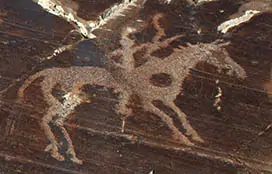
 Human habitation of what is now Mongolia dates back tens of thousands of years. The western region contains many examples of ancient human art — particularly in the form of deer stones and petroglyphs. The record that the prehistoric settlers left us, along with other archaeological findings, paints a clear picture of what their life was like. They were hunters who had domesticated the indigenous horses of the region and had mastered bow-and-arrow weaponry. Herding followed but gathering played a negligible role in their survival. Little that humans can eat grows here.
Human habitation of what is now Mongolia dates back tens of thousands of years. The western region contains many examples of ancient human art — particularly in the form of deer stones and petroglyphs. The record that the prehistoric settlers left us, along with other archaeological findings, paints a clear picture of what their life was like. They were hunters who had domesticated the indigenous horses of the region and had mastered bow-and-arrow weaponry. Herding followed but gathering played a negligible role in their survival. Little that humans can eat grows here.
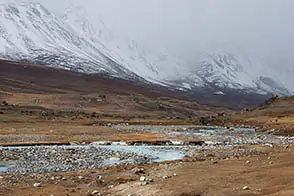 The topography and the climate of the whole region is dominated by the Altai Mountain range,
which also covers parts of Russia, China and Kazakhstan. The higher peaks of these mountains are permanently snow-capped. Winter at lower elevations lasts for five months. For these reasons life here has always been semi-nomadic out of necessity. Yet the mountains themselves form a natural barrier to human migration, so that the different peoples of the region historically remained separated. However, beginning around two hundred years ago the Kazakh people of eastern Kazakhstan began making their way over the mountains in search of new grazing pasture for their herds of sheep and goats.
The topography and the climate of the whole region is dominated by the Altai Mountain range,
which also covers parts of Russia, China and Kazakhstan. The higher peaks of these mountains are permanently snow-capped. Winter at lower elevations lasts for five months. For these reasons life here has always been semi-nomadic out of necessity. Yet the mountains themselves form a natural barrier to human migration, so that the different peoples of the region historically remained separated. However, beginning around two hundred years ago the Kazakh people of eastern Kazakhstan began making their way over the mountains in search of new grazing pasture for their herds of sheep and goats.
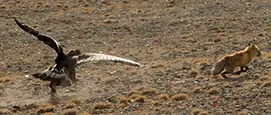 They were master horsemen but they did not hunt with bow and arrow. Instead they brought golden eagles which they had trained to hunt in Kazakhstan for centuries.
They were master horsemen but they did not hunt with bow and arrow. Instead they brought golden eagles which they had trained to hunt in Kazakhstan for centuries.
At first, they would migrate seasonally back to Kazakhstan. Later they settled in Mongolia. Now numbering over a hundred thousand, they are the largest ethnic minority in Mongolia. They are culturally different from the Mongol people.
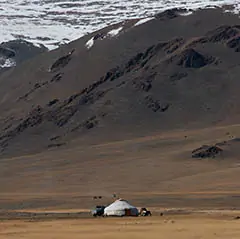 Their language, customs, dress and religion collectively distinguish them.
Their language, customs, dress and religion collectively distinguish them.
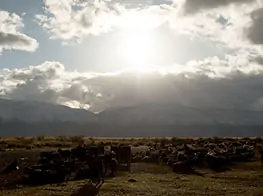 I recently spent a month in Mongolia's Bayan-Olgii Province (Aimag) living and traveling among them, spanning mid-autumn to the onset of winter.
I recently spent a month in Mongolia's Bayan-Olgii Province (Aimag) living and traveling among them, spanning mid-autumn to the onset of winter.
By mid-autumn the night time temperature is hovering around freezing point. Precipitation is already falling as snow on some peaks. But the Kazakh know what will follow and they regard this as mild rather than cold. Grazing is still good on the valley floors, and making sure the livestock take full advantage is paramount. So they continue to live in the gers (yurts) that have housed them since the spring. Kazakh gers are usually much larger than those of their Mongol neighbors and can house extended families.
A few hours south of the provincial capital, Olgii, lives a Kazakh eagle hunter named Erbol. He was my host and guide for a few days as I lived with him and his extended family in a guest ger. His seven-year-old grandson was having his hair cut on the day I arrived. That may not seem like a topic for inclusion in a cultural travel story, but this was no ordinary haircut.
Mongolia's Altail Kazakh have adopted a piece of Mongolian culture. Traditionally, children do not have their hair cut in the first few years of life. Then, the first haircut is a ceremonial coming-of-age event. For Erbol's family this was a two-day ceremony. Whereas only extended family and close friends were present on the first day, hundreds of guests had been invited for the second. I was also asked to cut the boy's hair — a great honor for an outsider. Below is a short video of some of the haircutting.
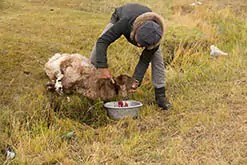
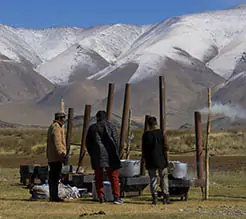 Before dark, five sheep and a horse had been slaughtered according to halal tradition. They would feed the guests the next day. Stoves had been removed from most of the gers (thankfully, not from mine) and placed about fifteen meters away. Whereas cooking is traditionally done by women in Kazakh society, here they played a role only in the preparation. A few men were to stay awake through the night and be in charge of the actual cooking. They were still there when I woke up, and it was mid morning before they began moving the meat and stew into four of the gers — which had been emptied to turn them into temporary eating gers.
Before dark, five sheep and a horse had been slaughtered according to halal tradition. They would feed the guests the next day. Stoves had been removed from most of the gers (thankfully, not from mine) and placed about fifteen meters away. Whereas cooking is traditionally done by women in Kazakh society, here they played a role only in the preparation. A few men were to stay awake through the night and be in charge of the actual cooking. They were still there when I woke up, and it was mid morning before they began moving the meat and stew into four of the gers — which had been emptied to turn them into temporary eating gers.
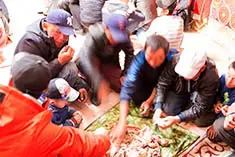 Then the guests began arriving. They were greeted by Erbol and then they mingled with each other.
Once all the guests had arrived (about 250 of them) the men and boys were separated
Then the guests began arriving. They were greeted by Erbol and then they mingled with each other.
Once all the guests had arrived (about 250 of them) the men and boys were separated
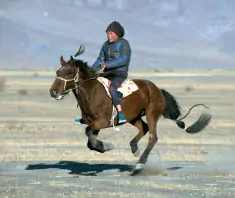 by ger from the women and girls. I was shown to one of the male gers where,
despite the language barrier, I made a few new friends. I also ate horse meat for the first time in my life.
by ger from the women and girls. I was shown to one of the male gers where,
despite the language barrier, I made a few new friends. I also ate horse meat for the first time in my life.
After lunch the ceremonies began. It was difficult to follow everything that was happening, but most of the activity was centered on the boy himself. Many speeches were made during which he was lavished with gifts that included at least two horses, seven sheep and money that must have totaled around US $1,000. Not bad for a seven year old in a relatively poor part of the world.
During ceremonies like these the Kazakh celebrate their heritage and a large part of the celebration featured horsemanship skill. There was a horse racing competition that gave an opportunity to other young boys from the surrounding communities to demonstrate how far they had progressed. From what I saw they had progressed far even by their mid teens. The event that I found the most fascinating though was another one with a Mongolian influence — wrestling. Below is a short video of some of that event.
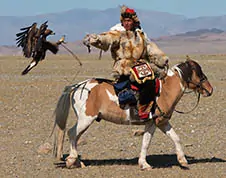
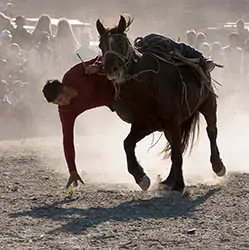 I went horseback riding into the low hills a couple of times with Erbol, who brought his eagle with him. Although hunting season hadn't started yet, it was still a wonderful experience to be riding alongside a real eagle hunter in the very same area where, in just a few weeks, eagles would be hunting their prey.
I went horseback riding into the low hills a couple of times with Erbol, who brought his eagle with him. Although hunting season hadn't started yet, it was still a wonderful experience to be riding alongside a real eagle hunter in the very same area where, in just a few weeks, eagles would be hunting their prey.
The most popular celebration of Kazakh culture in the area are the golden eagle festivals. The first (often called the small eagle festival) took place over a weekend outside the small village (soum) of Sagsai, about 45 minutes from Olgii. Here again, most of the events focused in some way on horsemanship skill. But the main event is the eagle competition itself. I'd seen documentary footage of eagle hunters
 successfully calling their bird to land on their arm. What I wasn't expecting was for over half the birds to fly away instead. But nothing can prepare you for the majesty of your first time witnessing an eagle being called and landing. The sense of admiration for the eagle hunter that it inspires is breathtaking.
successfully calling their bird to land on their arm. What I wasn't expecting was for over half the birds to fly away instead. But nothing can prepare you for the majesty of your first time witnessing an eagle being called and landing. The sense of admiration for the eagle hunter that it inspires is breathtaking.
 Although impressive, the Sagsai festival was the most disappointing of the three festivals I attended. Considering it has been going for quite a few years now, it was very badly organized. Only a week later, I attended the one I enjoyed the most. 2017 was the inaugural year for the one-day Ulaankhus (another small soum an hour west of Olgii) festival, which consisted only of an eagle competition and a ceremony of releasing eagles back into the wild.
Although impressive, the Sagsai festival was the most disappointing of the three festivals I attended. Considering it has been going for quite a few years now, it was very badly organized. Only a week later, I attended the one I enjoyed the most. 2017 was the inaugural year for the one-day Ulaankhus (another small soum an hour west of Olgii) festival, which consisted only of an eagle competition and a ceremony of releasing eagles back into the wild.
The scale of this festival was much smaller than the other two. Also, it hadn't been widely publicized and I was one of only a handful of outsiders present.
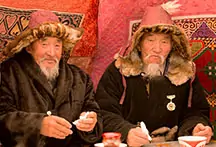 This made for a much more intimate experience. Even though it snowed, and the temperature was below freezing for the whole day, this festival was the most worthwhile to attend. In the lunch ger I met these two Kazakh elders. They are legendary eagle hunters who were being honored at the festival. Although the plan is for Ulaankhus to be an annual event, that may not happen. Organizations, including tour companies strangely enough, intend to petition the government to stop it beginning next year. Below is a video montage of the eagle calling portion of the competition.
This made for a much more intimate experience. Even though it snowed, and the temperature was below freezing for the whole day, this festival was the most worthwhile to attend. In the lunch ger I met these two Kazakh elders. They are legendary eagle hunters who were being honored at the festival. Although the plan is for Ulaankhus to be an annual event, that may not happen. Organizations, including tour companies strangely enough, intend to petition the government to stop it beginning next year. Below is a video montage of the eagle calling portion of the competition.
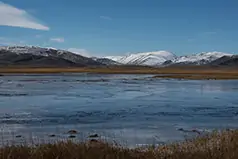
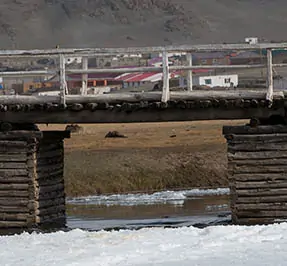 I had a week between the Ulaankhus festival and the main Olgii festival, which I spent exploring the westernmost parts of the province. By now the onset of winter had really begun. It was rarely above freezing and lakes and streams had become frozen save for a few hours at the height of the day. Tsengel is the next soum west of Ulaankhus. After that very few people live out here. I passed through another small soum after a few hours. This one exists mainly to provide a boarding school for the children of area nomads.
I had a week between the Ulaankhus festival and the main Olgii festival, which I spent exploring the westernmost parts of the province. By now the onset of winter had really begun. It was rarely above freezing and lakes and streams had become frozen save for a few hours at the height of the day. Tsengel is the next soum west of Ulaankhus. After that very few people live out here. I passed through another small soum after a few hours. This one exists mainly to provide a boarding school for the children of area nomads.
 Although most families have packed up their gers and moved into their winter homes by this time of year,
I did see a few gers still inhabited here and there. Herding is a perennial task but time is also spent preparing for the dead of winter. Temperatures can fall into the negative forties centigrade and just going outside can be life-threatening.
Although most families have packed up their gers and moved into their winter homes by this time of year,
I did see a few gers still inhabited here and there. Herding is a perennial task but time is also spent preparing for the dead of winter. Temperatures can fall into the negative forties centigrade and just going outside can be life-threatening.
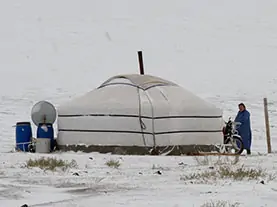 So early winter is also a time to stock up on fuel (mainly dried animal dung and coal)
and to make sure the home is as protected as it can be from the elements. Once winter has begun in earnest this is as close as humans come to hibernation. The main pastime is simply to avoid dying!
So early winter is also a time to stock up on fuel (mainly dried animal dung and coal)
and to make sure the home is as protected as it can be from the elements. Once winter has begun in earnest this is as close as humans come to hibernation. The main pastime is simply to avoid dying!
Bayan-Olgii has about a dozen small soums in addition to Olgii itself. These modern, permanent settlements now have 24-hour electricity (in theory — the power often goes out for hours at a time).
 Urbanization of the population has been happening in Mongolia at a staggering rate since the transition from communism to democracy.
This is also the trend in Bayan-Olgii For the Altai Kazakh people
Urbanization of the population has been happening in Mongolia at a staggering rate since the transition from communism to democracy.
This is also the trend in Bayan-Olgii For the Altai Kazakh people
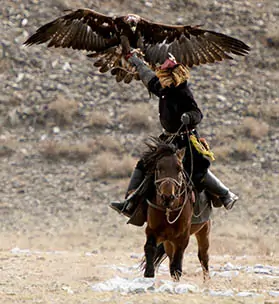 this inevitably brings some loss of tradition and culture. But in rural parts Kazakh culture is alive and well.
this inevitably brings some loss of tradition and culture. But in rural parts Kazakh culture is alive and well.
Probably the best example of cultural preservation is the main golden eagle festival that takes place each year just outside Olgii. This was the last festival I attended. Attendance was higher than the previous year. That was no doubt due, in part at least, to the release of the film, The Eagle Huntress. Nurgaiv Aisholpan competed for the fourth time alongside other females.
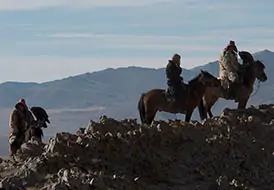 But, of course, it was a male-dominated competition.
But, of course, it was a male-dominated competition.
My final cultural interaction was with two brothers who live near Ulaankhus and who are both eagle hunters.
Siezbek and Khazibek were my hosts and guides for a hunting expedition. We set off, along with their spotter, on an unusually warm winter morning and headed for a high ridge about fifteen kilometers from their home.
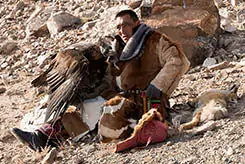 Conditions were less than ideal and I didn't hold much hope for a successful hunt.
Conditions were less than ideal and I didn't hold much hope for a successful hunt.
After maybe an hour the spotter shouted "fox!"
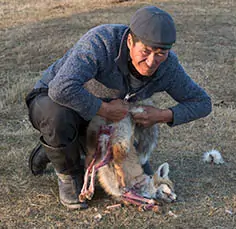 The eagle hunters descended the ridge but were unable to see it.
It had gotten away. So they rode back up to the top of the ridge and we waited. We didn't have to wait long before the spotter sighted a second fox.
He flushed it out into the open and Siezbek released his eagle. The eagle made no mistake and the kill was instant.
The eagle hunters descended the ridge but were unable to see it.
It had gotten away. So they rode back up to the top of the ridge and we waited. We didn't have to wait long before the spotter sighted a second fox.
He flushed it out into the open and Siezbek released his eagle. The eagle made no mistake and the kill was instant.
We returned home where, on this occasion, the fox was awarded to the spotter. He had it skinned in a matter of minutes. The fur will provide clothing for his family and the meat was the eagle's reward. It was a fitting end to my Kazakh tours.
Our documentary, The Last Kazakh Nomads of Mongolia is now available. Click or tap below to watch the trailer on YouTube.
Photography and videography copyright © 1999 -
2025,
Ray Waddington. All rights reserved.
Text copyright © 1999 -
2025,
The Peoples of the World Foundation. All rights reserved.
Waddington, R., (2017) Kazakh Tours. The Peoples of the World Foundation. Retrieved
November 17, 2025,
from The Peoples of the World Foundation.
<https://www.peoplesoftheworld.org/travelStory.jsp?travelStory=kazakhtours>
Inaugural Alma Kuk Golden Eagle Festival (short film on YouTube).
Halal/Haram Horse Ritually Slaughtered and Butchered (short film on YouTube).
Eagle Hunting: A Day with Mongolia's Eagle Hunters (short film on YouTube).
Erecting a Kazakh Ger (short film on YouTube).
Travel review, advisory and warning: Blue Wolf Travel, Olgii, Mongolia.
If you enjoyed reading this travel story, please consider buying us a coffee to help us cover the cost of hosting our web site. Please click on the link or scan the QR code. Thanks!



